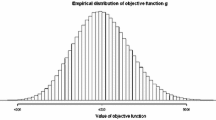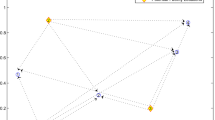Abstract
In order to evaluate the behavior of three probabilistic location set covering models we propose a new method that allows the ex-post measurement of the so called “minimum local reliability level”, both under the independence and under the dependence assumption. We show experimentally, by means of a set of test problems, that the proposed loss-system version of Ball and Lin's model (1993) does almost always achieve the required reliability level. Moreover, if we compare this new version with the other two already known probabilistic models and consider as a second additional criteria the least number of required vehicles, we show that the new version has a better behavior both under the independence and the dependence assumption. In this paper we further propose a new model with the aim of reducing the number of required vehicles while satisfying the fixed reliability level. Our new model is formulated like Ball and Lin's model incorporating the servers workload estimate of the Binomial PLSCP of ReVelle and Hogan (1988). Finally, we check the precision of our ex-post evaluation method over the four considered models through a simulation study.
Similar content being viewed by others
References
M. Ball and F. Lin, A reliability model applied to emergency service vehicle location, Operations Research 41 (1993) 18-36.
R. Batta, J.M. Dolan and N.N. Krishnamurthy, The Maximal Expected Covering Location Problem: revisited, Transportation Science 23 (1989) 277-287.
R. Batta and N.R. Mannur, Covering-location models for emergency situations that require multiple response units, Management Science 36(1) (1990) 16-23.
J.M. Benedict, Three hierarchical objective models which incorporate the concepts of excess coverage to locate EMS vehicles or hospitals, M.S. thesis, Department of Civil Engineering, Northwestern University, Evanston, IL (1983).
G.R. Berlin and J.C. Liebman, Mathematical analysis of emergency ambulance location, Socio-Economic Planning Sciences 8(6) (1974) 323-328.
F. Borras, Nuevos modelos probabilísticos de localización de servicios de emergencias, Ph.D. thesis, Departamento de Estadistica y Matematica aplicada, Universidad Miguel Hernandez de Elche (2000).
T.H. Burwell, J.P. Jarvis and M.A. McKnew, Modeling co-located servers and dispatch ties in the hypercube model, Computers and Operations Research 20(2) (1993) 113-119.
T.H. Burwell, M.A. McKnew and J.P. Jarvis, An application of a spatially distributed queuing model to an ambulance system, Socio-Economic Planning Sciences 26(4) (1992) 289-300.
S. Chapman and J.White, Probabilistic formulation of emergency service facilities location problems, Paper presented at the ORSA/TIMS Conference, San Juan, Puerto Rico (1974).
R. Church and C. ReVelle, The Maximal Covering Location Problem, Papers of the Regional Science Associaton 32 (1974) 101-118.
M.S. Daskin, A maximum expected covering location problem: Formulation, properties and heuristic solution, Transportation Science 17 (1983) 48-70.
M.S. Daskin and E.H. Stern, A hierarchical objective set covering model for emergency medical service vehicle deployment, Transportation Science 15(2) (1981) 137-152.
D.J. Eaton, M. Hector, V. Sanchez, R. Lantigua and J. Morgan, Determining ambulance the deployment in Santo Domingo, Dominican Republic, Journal of the Operational Research Society 37(2) (1986) 113-126.
J.A. Fitzsimmons, A methodology for emergency ambulance deployment, Management Science 19(6) (1973) 627-636.
O. Fujiwara, T. Makjamroen and K.K. Gupta, Ambulance deployment analysis: A case study of Bangkok, European Journal of Operational Research 31 (1987) 9-18.
J. Goldberg, R. Dietrich, J. Ming and M.G. Mitwasi, A simulation model for evaluating a set of emergency vehicle base locations: Development, validation and usage, Socio-Economic Planning Sciences 24(2) (1990) 125-141.
J. Goldberg, R. Dietrich, J. Ming and M.G. Mitwasi, Validating and applying a model for locating emergency medical vehicles in Tucson, AZ. European Journal of Operational Research 49 (1990) 308-324.
J. Goldberg and L. Paz, Locating emergency vehicle bases when service time depends on call location, Transportation Science 25 (1991) 264-280.
J. Goldberg and F. Szidararovszky, Methods for solving equations used in evaluating emergency vehicle busy probabilities, Operations Research 39(6) (1991) 903-916.
K. Hogan and C. ReVelle, Concepts and applications of backup coverage, Management Science 32(11) (1986) 1434-1444.
J.P. Jarvis, Optimization in stochastics systems with distinguishables servers, Technical Report TR-19-15, Operations Research Center, MIT (1975).
J.P. Jarvis, Approximating the equilibrium behavior of multi-server loss systems, Management Science 31 (1985) 235-239.
P. Kroll, The multiple-depot, multiple-tour and multiple-stop delivery problem, Ph.D. dissertation, The Johns Hopkins University, Baltimore, MD (1988).
R.C. Larson, A hypercube queuing model for facility location and redistricting in urban emergency services, Computers Operations Research 1 (1974) 67-95.
R.C. Larson, Appoximating the performance of Urban Emergency Service Systems, Operations Research 23 (1975) 845-868.
M.S. Liu and J.T. Lee, A simulation of a hospital emergency call system using SLAM, Simulation 51(6) (1988) 216-221.
V. Marianov and C. ReVelle, The Queuing Probabilistic Location Set Covering Problem and some extensions, Socio-Economic Planning Science 28 (1994) 67-178.
V. Marianov and C. ReVelle, Siting emergency services, in: Facility Location: A Survey of Applications and Methods, ed. Z. Drezner, Springer Series in Operations Research (1995) chapter 10.
V. Marianov and C. ReVelle, The Queueing Maximal Availability Location Problem: A model for the siting of emergency vehicles, European Journal of Operational Research 93(1) (1996) 110-120.
J.F. Repede and J.J. Bernardo, Developing and validating a decision support system for locating emergency medical vehicles in Louisville, Kentucky, European Journal of Operational Research 75 (1994) 567-581.
C. ReVelle and K. Hogan, A reliability constrained siting model with local estimates of busy fractions, Environment and Planning B 15 (1988) 143-152.
C. ReVelle and K. Hogan, The Maximum Availability Location Problem, Transportation Science 23 (1989) 192-200.
C. ReVelle and K. Hogan, Themaximum reliability location problem and ?-reliable p-center problem: Derivates of the probabilistic location set covering problem, Annals of Operations Research 18 (1989) 155-174.
E. Savas, Simulation and cost-effectiveness analysis of New York's emergency ambulance service, Management Science 15(12) (1969) 608-627.
D. Serra, The pq-median problem: Location and districting of hierarchical facilities, Ph.D. thesis, Department of Geography and Environmental Engineering, John Hopkins University (1989).
R. Swain, A descomposition algorithm for a class of facility location problems, Ph.D. thesis, Cornell University, Ithaca, NY (1971).
C. Swoveland, D. Uyeno, I. Vertinsky and R. Vickson, Ambulance location: A probabilistic enumeration approach, Management Science 20(4) (1973) 686-698.
C. Toregas, R. Swain, C. ReVelle and L. Bergman, The location of emergency service facilities, Operations Research 19 (1971) 1363-1373.
D. Uyeno and C. Seeberg, A practical methodology for ambulance location, Simulation 43(2) (1984) 79-87.
J. White and K. Case, On covering problems and the central facility location problem, Geographical Analysis 6(3) (1974) 281.
Author information
Authors and Affiliations
Rights and permissions
About this article
Cite this article
Borrás, F., Pastor, J.T. The Ex-Post Evaluation of the Minimum Local Reliability Level: An Enhanced Probabilistic Location Set Covering Model. Annals of Operations Research 111, 51–74 (2002). https://doi.org/10.1023/A:1020941400807
Issue Date:
DOI: https://doi.org/10.1023/A:1020941400807




